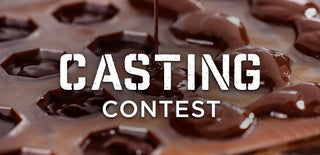Introduction: Cardboard Casting Mold Test Series
Concrete casting has been in for quite some time, but I just never got around to trying it.
With mothers day around the corner and a number of spare glass testing tubes at hand which had been given to me, I finally had an idea of what to do:
A personalized mini vase using the letters of her fist names.
I thought I'd just ask around and find out easily enough how to prepare cardboard molds in a manner, that the concrete wouldn't stick to it.
Well - no.
Nobody knew! I got some advise as to how to prepare silicon molds and of course the internet is full of concret dragon lights tutorials, but I couldn't find anything about custom made cardboard molds.
So I made my own molds and started a mini test series.
Step 1: Gathering Supplies
My mini test series tried the following variations:
- aluminum foil inlay (half the mold oiled the other not)
- plastic wrap inlay
- spray paint
- baby cream
- no inlay but the mold brushed with sewing machine oil
- no inlays or anything plain cardbord
In Step 5 I will explain the making of the molds, it is very simple and straightforward.
Step 2: Preparing the Molds
After I had made my molds I prepared them.
- plastic wrap: is really hard to put into the mold. It doesn't stick to cardboard so it kept slipping and was generally a pain to put in.
- aluminum foil: was a lot better to put in than the plastic but far from comfortable because often, when I tried to flatten it to the mold really nicely - it tore.
- baby cream: I hated it! Sticky, stupid to apply with a brush, so I used my fingers, kept beeing sticky till the end. Super for babies, don't use it for molds! (I hated it so much I never even took a photo)
- spray paint: yey, cool, nice and easy.
- sewing machine oil: easily applied.
- no additives: well obviously easiest!
Step 3: Casting
I prepared the concrete as explained and poured or rather spooned it into the molds.
Step 4: Adding the Vase/vases
I truly evolved in this step.
The first photos show my complicated and really not all too successful attempt -using clothes pins and sand. I filled the glass tubes with sand, so that they wouldn't swim up in the concrete.
This was totally useless because I used pins to secure anyway. The clothespins were really hard to adjust on the brim of the mold and kept coming off balance because only one part of the pin acually lay on the brim.
It resulted in quite crooked vases.
Then I changed my tactics and am very pleased with the result:
I simply punched a hole in a leftover strip of cardboard and extended the hole by making four short cuts from the center outwards. Now I could push the tube through exacty as deep as I wished and because the strip had more brims to lie on it was super stable and resulted in a perfectly straight vase.
Step 5: Unpacking
- plastic wrap: Super! Perfect to get off. I thought it would stick to the concrete, but NOT at all. It was hard to pull it out of all the little crooks, but definetely opens a lot of new ways of exploration. Not necceccarily perfect for my project, but overall very cool outcome. The heart was in the plastic wrap. Also super because the mold stayed in one piece!
- aluminum foil: No No No. A total mess and really hard to get off. I could not get everything off. The oiled half of the mold was better, but I do not recomend it. I had to tear the cardboard and the foil of. Messy.
- baby cream: Sticky, nasty, even sticky on the dry concrete! No no no.
- spray paint: yey, cool, nice and easy again. The mold gets destroyed in the unwrapping but some of the paint stays on the concrete. In my case the K has a silver lining. Wow. Totally love it!!
- sewing machine oil: As before, the mold gets destroyed, but the cardboard rubbes of and you get the most concrety effects here.
- no additives: Weirdly enough the results were quite good. The G is my test letter here and you can see some of the original cardboard but not too much. If you wanted to paint it later anyway my advise would be to save the hassle and don't prepare the mold with anything.
Step 6: Cardboard Mold Making
The first molds I made were made of copier paper boxes, the last ones of the lid of a pizza box. The pizza box is perfect because it is white on one side.
Just cut straight stripes of the same width for your outer borders and some squares for the base. Form the mold as you like and then tape it to the base. The more thoroughly you do this, the less concrete will flow under the rim.
Nothing happens should some concrete flow through, after it is properly cured you can just break the superfluous bits off.
Step 7: Like What You Make

Participated in the
Casting Contest











